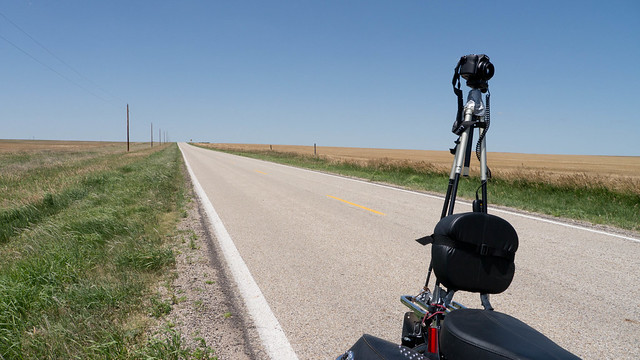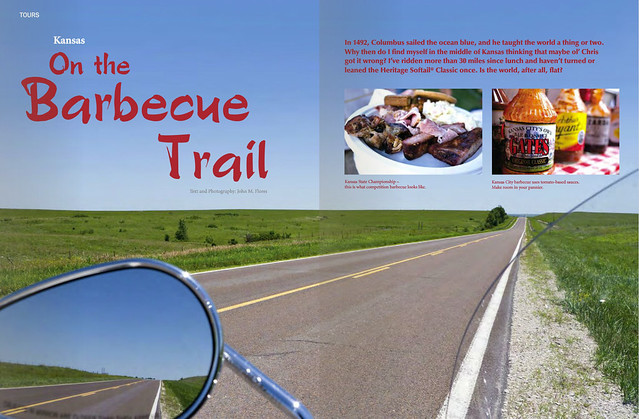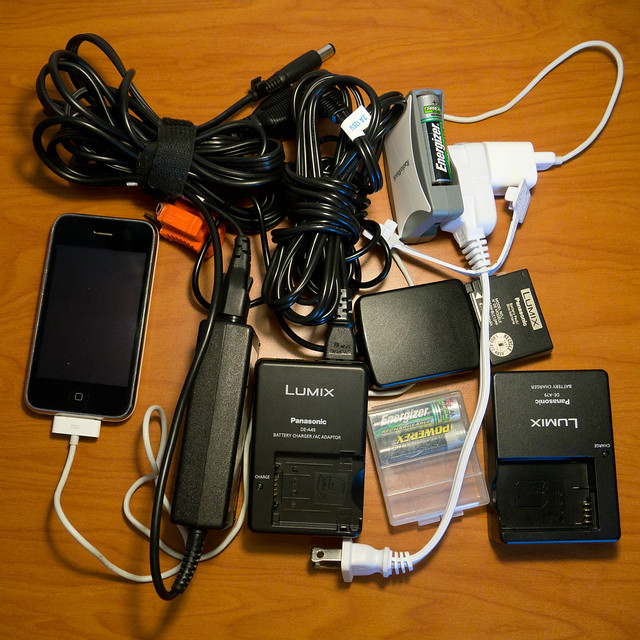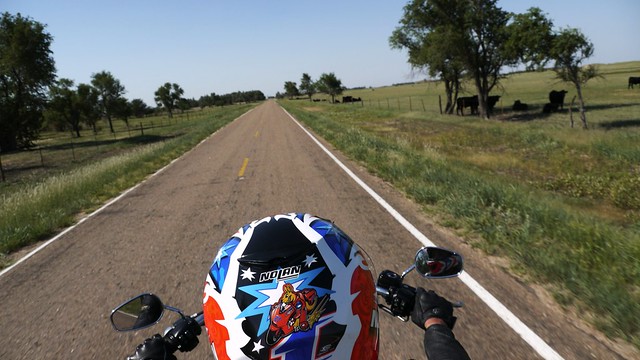In the seven years that I’ve been writing motorcycle travel stories, I’ve used a number of cameras, from Nikon and Pentax dSLRs to advanced point-and-shoots from Canon and Ricoh. Last summer I travelled for RoadRUNNER Magazine to Kansas to do a trip on riding and eating barbecue there. It was my first trip using Micro Four-Thirds cameras. Here’s what I brought:
- Bodies – GH2, GH1
- Lenses – 14-140mm F4.0-5.8, 100-300 F4.0-5.6, 20 F1.7
- Tripod – Velbon Ultra Maxi SF
- Bag – LowePro Stealth Reporter 400 AW
- Photo storage – HP Mini Note netbook
It’s great having all of this technology on a trip, but it does come at a price:
The Harley-Davidson Heritage Softtail Classic did have soft bags, but fitting all of my clothes, rain gear, running shoes (after all, I was going to eat barbecue twice a day for nearly a week!), and electronics was a challenge, and at the end of each day, the first thing I did in my hotel room was locate all of the accessible outlets and plug everything in for an overnight recharge.
Here’s the story as published:
http://www.calameo.com/read/0003721363ce742121b34?authid=dlLhiKAXUIHr
Overall, I was very satisfied with the Panasonic gear on this trip. The image quality of the photos is no different than what I’ve achieved in the past. Nobody at the magazine asked me what camera I used or questioned the quality of the images. So in that sense, Micro Four-Thirds just worked. Nuff said.
Now some specific notes about the gear:
GH1/GH2
From an image quality standpoint, these cameras are virtually identical. But as I observed before the trip, Panasonic has made the GH2 a much more usable photographer’s tool by changing a number of small things…
- The rear dial of the GH2 falls readily to hand. With the GH1 front dial I have to change my grip to use it and then change my grip again to take the photo.
- You can set up the GH2 EVF to give a realtime preview of exposure and depth of field. The GH1 brightens the screen in low light and can’t be trusted.
- Changing the focus point on the GH2 is as simple as touching the rear LCD. On the GH1 it is a multi-button-press affair.
While these may sound like niggles, they get in the way. As fun as these trips are, they are also work, stopping repeatedly on the side of the road throughout the day to take photos. On this trip in particular, it was 100F degrees or darn close to it for several days, and every time I stopped I sweated buckets in my riding gear. I usually end up behind schedule each day because I’ve stopped so often to take pictures, and am thus rushing at the end of the day to get to my hotel room. Under those conditions, anything that slows me down gets annoying real quickly.
On the positive side, the flip-twist LCD of both cameras is a joy. I can achieve camera angles that I used to have to lie on the ground for. I can also quickly compose and take a shot without taking my helmet and gloves off. The screens do wash out in bright light, and hand-holding the 100-300 while using the rear LCD is a bit of a hit or miss affair; the additional stability you get from bringing the camera up to your eye cannot be denied. The resistive touch screen of the GH2 is great on the road too, as I didn’t have to remove my gloves.
Looking at the photos now, I can see situations where I wish I had a little bit more dynamic range, as some of the shadows gets pushed to black as I tried to preserve the highlights. This is particularly challenging when trying to photograph a black bike on a sunny day. It’s times like this when I wish I had the Pentax K-5 or even K-x with me. They have a bit more dynamic range and in certain situations that shows. It’s something that hard to describe but I call “organic”. By “organic” I mean less bold, in-your-face-a-bit, higher contrast, and more balanced and nuanced. This also shows up in post processing, as my Pentax RAW files are easier to push around before blowing out or crushing. But the current style is more towards high contrast anyways, and magazine prints tend in that direction too, so the GH1 and GH2 are fine for this type of work.
And others have mentioned that the Panasonic sensors are a bit noisy even at base ISO. They are, but the noise in minimal, easily cleaned up, and didn’t show up in the magazine. The magazine, btw, prides itself on its photography and prints on nicer than average paper.
Would I bring this pair with me on another trip? Yes, but I’d much rather have two cameras that have matching chargers. On the other hand, I got the GH1 so cheaply ($299) that I’m willing to place it in harm’s way, like sitting on top of a tripod duct taped to the sissy bar while traveling 40mph:
Would I be willing to do that with a more expensive camera? Yes, but I’d be less happy about it! Ultimately, I could see myself doing a trip like this with a pair of GH2s or a pair of G3s or a pair of GX1s. The only benefit to the GH1/GH2 combo is that I’ve already paid for them!

14-140mm F4.0-F5.8
This was the workhorse of the trip, with most of the published photos. I’ve had a checkered past with this lens – not liking at first then liking it a little more, then being disappointed in it’s video performance in low light, and now really playing to its strengths. At the end of the day, it really is a high-quality do-it-all lens in a relatively small package for it’s focal range. The Optical Image Stabilization is a boon as well.
What this lens is not good for is any rigged shots with the camera hanging from the bike. It’s just too heavy. On the Harley Davidson Heritage Softail Classic I was riding, the heavy lens plus vibrations from the motorcycle conspired to overwhelm the small ballhead I was using, and after just a short distance, the camera was pointing straight down. I actually tried to buy an Olympus 9-18mm or Panasonic 14mm F2.5 pancake as I rode through Wichita. Alas, it was Sunday and the stores that were open did not have them in stock. I ended up using the 20mm F1.7 a couple of times, but the focal length was a bit long for this type of shot.
I wouldn’t hesitate to bring this lens with me again.
100-300mm F4.0-F5.6
Only two of the published photos were taken with this lens. Nice photos for sure, and I have more nice photos that didn’t get published. Optically, I’d rate it better than the 14-140mm. But I’m not sure if I’ll take this on the road with me again – not enough situations to justify its space in the bag.
20mm F1.7
This lens was a perfect complement to the 14-140, small, light, and fast. This was the lens I glued to the GH2 when the lights went down. I’ve liked this lens from the moment I started using. Yes, it’s a touch slower to AF than other lenses. And the newer Panasonic-Leica 25mm F1.4 is more desirable (as is the Voightlander 25mm F0.95). But this lens is a peach, the cheap fast 50 for the modern age.
Primes vs. Zooms
Primes are cool. And fast. And small. And in the past they’ve been my go-to package when travelling light with my Pentax gear.
With the Pentax and other dSLRs, primes are the only way to go small. But in the mirrorless world, the 14-140mm paired with the 20mm F1.7 has really opened my eyes. I think that I could travel the world with this setup and be happy. Maybe I’d add the Panasonic 14mm F2.5 for rigged shots. It’s so small and light that I’ve misplaced it somewhere in the house! Maybe I’d add the Olympus 45mm F1.8 because it’s so small and good. Uh, oh, the kit’s starting to bloat again!
Final Thoughts
What I bring on the next trip will depend upon how far I’m going and how much luggage space I’ve got. Ultra small could be a couple of GX1s with the 14mm F2.5, 20mm F1.7, and 45mm F1.8. I could add an EVF to that kit and I’d be done. I’d lose out a little on the long end to the 14-140mm but that would be a sweet setup.
Could I go smaller still? For sure. The GF3 is pretty small, as is the Olympus E-PM1. Outside of the world of Micro Four-Thirds, there are all-in one cameras like the Fuji X10, the recently-announced Canon G1X, as well as the Nikon 1 system. What about smaller sensor compacts like the G12, Fuji X10, the Olympus XZ-1, and the small sensor Pentax Q system? They could work. In fact, one of my last stories featured a two-page spread of a photo taken with the positively ancient Canon G10:
As good as they are, I’m not quite ready to commit to them. Right now Micro Four-Thirds is the sweet spot for me – bokeh when I want it, depth of field when I don’t, and a small-enough package for motorcycle travel.






